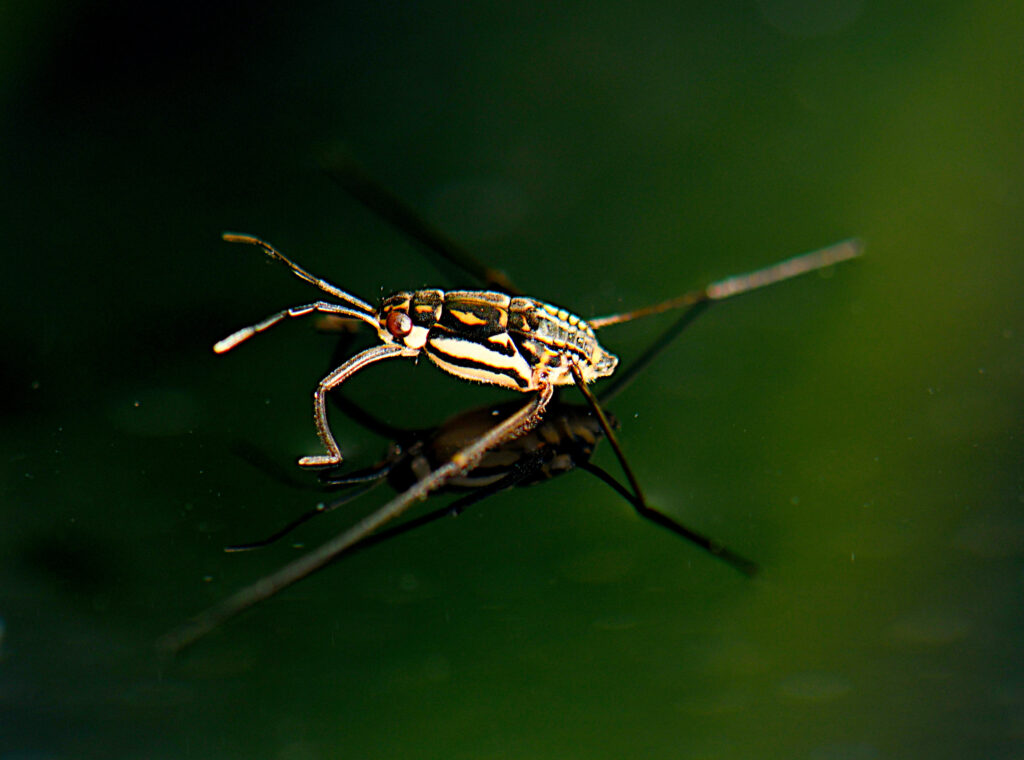Winter in Maine is coming to a close. The snow is finally melting and the so-called mud season is ushering in new beginnings with the roar of surging rivers and the filling of vernal pools. Victor Ortega-Jiménez, newly appointed to his first faculty position at the University of Maine, is walking down to a lake to observe Trepobates water striders, similar to those he had studied as a postdoctoral scholar at the University of California, Berkeley. As a self-described “animal dynamicist,” he is interested in the mechanics of life at the interface between water and air. His prior work took a physical perspective on understanding how these insects, spider-like in appearance, glided and zig-zagged across the surface tension of the water. But on this occasion, he sees something different: the water striders are jumping, as if their lives depended on it—“like popcorn,” Ortega-Jiménez said.
A scene of gliding and jumping water striders in Eastbrook, Maine. Video courtesy of Victor Ortega-Jiménez.
The question that arose in Ortega-Jiménez’ mind was not how these water striders were jumping, which had already been worked out by others. Rather, he wondered: how are they landing so gracefully? Upon bringing them back to his lab, he quickly found that they tended to rotate their legs mid-air in a particular manner as to land with the abdomen pointing downwards into the water surface. This posture prevented their bouncing out of control because of a small hydrophilic patch on the abdomen that attached to the water upon contact. The landing manoeuvre was consistent—every individual he captured on high-speed film executed it successfully.
Slow motion videos often prove very useful for understanding complex movements. Here you can watch a water strider leap, right, and land, all without breaking the surface of the water. Video courtesy of Victor Ortega-Jiménez.
This surprising observation brought Ortega-Jiménez’ thoughts back to his days studying an organism closely related to insects: springtails. These curious hexapods launch off of surfaces with their tails, true to their name. Like water striders, they land with their abdomen down, but instead of using their legs in the air, springtails morph their bodies in a way that makes their preferred orientation the most aerodynamically stable. As a result, they can simply let the air twist them around with minimal effort, analogous to how a badminton shuttlecock always orients itself nose-down. Ortega-Jiménez later recognized similarities between springtails and human cannonball circus acts, who tend to land on their backs. These two possibly share similar repercussions for a failed landing: “I remember I filmed this cannonball man in a Atlanta fair and I observed that they are accelerating a lot and when they are landing actually they are doing the same thing as the springtail… They need to land like this because if they land in a straight way they will die because they will penetrate the net.”
Ortega-Jiménez’ next goal was to determine how water striders were achieving a similar control strategy. So, he put a twist on a classic tool used in biomechanics and built a vertical wind tunnel that simulated falling by blowing air upwards in a way that could suspend an insect. The result? The water striders stayed upright with ease, bending their legs behind their bodies like tiny parachutes and letting the air twist them around. Even those that tumbled after an aerial jump attempt could swiftly recover back into their preferred landing orientation. That these often-wingless water striders are so adept at aerial control, and that springtails share a similar strategy which likely existed before anything on Earth had evolved flight, may yield insight into the evolution of insect flight, Ortega-Jiménez notes.
Sometimes when you look at a system in a novel way, discoveries keep coming. Although Ortega-Jiménez initially put aside the water striders he collected from the vernal pools to focus on other projects, his attention was quickly turned back as the first instars (juveniles) in the lab began to emerge… and jump! “I was expecting [landing] to be more effective when [they] are older… But it seems like it’s not, because even the instars, they are landing 100% right… that’s something that is very clean, a hypothesis that this is pre-programmed,” Ortega-Jiménez said. And not only could the first instars jump and land perfectly, but mating pairs (a male attached to the back of a female) could as well. It became clear then that this jumping and righting was not just a cool quirk, but a vital component of the life of a water strider.

To understand why jumping is so important, let us zoom in further to a bug’s eye view of life as a water strider. You may think of water striders as daytime warriors, perhaps active for only a few hours at a time. But, as Ortega-Jiménez found when he left a camera to record Trepobates for 24 hours, they are actually active day and night. He compares them to swifts, a group of birds similar to swallows: “There are some species of swifts that they can just fly 90% of their lives and they are just landing when they are mating… These water striders are the swifts of the interface [between water and air].” One possible reason for the water striders’ constant activity is that they evolved in rivers, which can be unforgiving environments. Small invertebrates that become prey for the water striders upon falling onto the water come sporadically from upstream, and if the water striders stop to rest they may drift and miss out on these easy nutrients. Regardless of the reason, some water striders end up moving just as far as migrating flies despite appearing to stay in the same place, Ortega-Jiménez says. He goes on to explain that because the river surface is so cutthroat, these water striders often resort to cannibalism, which they may try to escape via jumping: “[I] suspect that they are doing this behavior because [of] cannibalism. And it’s no surprise because some animals that migrate like the locusts, they are [also] driven by cannibalism.”
Among the many reasons that water striders are so interesting is that they thrive in a unique environment where few other animals can. Ortega-Jiménez, now beginning his next chapter as an Assistant Professor of Integrative Biology at the University of California, Berkeley, is continuing to work on life at the air-water interface and beyond. To that end, he works (and thrives) at a boundary himself, regularly bridging biology, physics, and engineering. This story is a perfect example: what started with a simple observation in nature evolved into an immensely integrative project using high-speed filming, a wind tunnel, aerodynamic theory, and river ecology, all to get at the question: what is it like to be a water strider? His approach of studying how physical forces like aerodynamics and electrostatics affect animal movement, and how animals take advantage of those forces, is why Ortega-Jiménez calls himself an animal dynamicist. But he makes clear that while he loves thinking and working in the lab, his inspiration comes first and foremost from the natural world: “I am a biologist and I love to go to nature… And I think that’s the point of the inspiration, just to be relaxed, just to be like open to these new observations. And sometimes it happens, just the click of, oh, this is very interesting. And then everything starts from there.”
Author Bio:
 Brady Nichols is a first-year PhD student in the Animal Behavior Graduate Group at the University of California, Davis, advised by Dr. Stacey Combes. His research interests span biomechanics, fluid dynamics, and insect ecology and evolution. He hopes to use a combination of field work and mathematical theory to better understand the role of turbulence in insect flight, including in smaller-scale flight mechanics and more broadly in insect foraging, dispersal, and/or migration. Outside of work, he enjoys cooking, riding his bike, climbing rocks, and watching whatever birds and bugs he can find.
Brady Nichols is a first-year PhD student in the Animal Behavior Graduate Group at the University of California, Davis, advised by Dr. Stacey Combes. His research interests span biomechanics, fluid dynamics, and insect ecology and evolution. He hopes to use a combination of field work and mathematical theory to better understand the role of turbulence in insect flight, including in smaller-scale flight mechanics and more broadly in insect foraging, dispersal, and/or migration. Outside of work, he enjoys cooking, riding his bike, climbing rocks, and watching whatever birds and bugs he can find.

